The NVIDIA GeForce GTX 980 Ti Review
by Ryan Smith on May 31, 2015 6:00 PM ESTPower, Temperature, & Noise
As always, last but not least is our look at power, temperature, and noise. Next to price and performance of course, these are some of the most important aspects of a GPU, due in large part to the impact of noise. All things considered, a loud card is undesirable unless there’s a sufficiently good reason – or sufficiently good performance – to ignore the noise.
As the GM200 flagship card, GTX Titan X gets the pick of the litter as far as GM200 GPUs go. GTX Titan X needed fully-functional GM200 GPUs, and even then needed GPUs that were good enough to meet NVIDIA’s power requirements. GTX 980 Ti on the other hand, as a cut-down/salvage card, gets second pick. So we expect to see these chips be just a bit worse; to have either functional units that came out of the fab damaged, or have functional units that have been turned off due to power reasons.
| GeForce GTX Titan X/980 Voltages | ||||
| GTX Titan X Boost Voltage | GTX 980 Ti Boost Voltage | GTX 980 Boost Voltage | ||
| 1.162v | 1.187v | 1.225v | ||
Looking at voltages, we can see just that in our samples. GTX 980 Ti has a slightly higher boost voltage – 1.187v – than our GTX Titan X. NVIDIA sometimes bins their second-tier cards for lower voltage, but this isn’t something we’re seeing here. Nor is there necessarily a need to bin in such a manner since the 250W TDP is unchanged from GTX Titan X.
| GeForce GTX 980 Ti Average Clockspeeds | |||
| Game | GTX 980 Ti | GTX Titan X | |
| Max Boost Clock | 1202MHz | 1215MHz | |
| Battlefield 4 |
1139MHz
|
1088MHz
|
|
| Crysis 3 |
1177MHz
|
1113MHz
|
|
| Mordor |
1151MHz
|
1126MHz
|
|
| Civilization: BE |
1101MHz
|
1088MHz
|
|
| Dragon Age |
1189MHz
|
1189MHz
|
|
| Talos Principle |
1177MHz
|
1126MHz
|
|
| Far Cry 4 |
1139MHz
|
1101MHz
|
|
| Total War: Attila |
1139MHz
|
1088MHz
|
|
| GRID Autosport |
1164MHz
|
1151MHz
|
|
| Grand Theft Auto V |
1189MHz
|
1189MHz
|
|
The far more interesting story here is GTX 980 Ti’s clockspeeds. As we have pointed out time and time again, GTX 980 Ti’s gaming performance trails GTX Titan X by just a few percent, this despite the fact that GTX 980 Ti is down by 2 SMMs and is clocked identically. On paper there is a 9% performance difference that in the real world we’re not seeing. So what’s going on?
The answer to that is that what GTX 980 Ti lacks in SMMs it’s making up in clockspeeds. The card’s average clockspeeds are frequently two or more bins ahead of GTX Titan X, topping out at a 64MHz advantage under Crysis 3. All of this comes despite the fact that GTX 980 Ti has a lower maximum boost clock than GTX Titan X, topping out one bin lower at 1202MHz to GTX Titan X’s 1215MHz.
Ultimately the higher clockspeeds are a result of the increased power and thermal headroom the GTX 980 Ti picks up from halving the number of VRAM chips along with disabling two SMMs. With those components no longer consuming power or generating heat, and yet the TDP staying at 250W, GTX 980 Ti can spend its power savings to boost just a bit higher. This in turn compresses the performance gap between the two cards (despite what the specs say), which coupled with the fact that performance doesn't scale lineraly with SMM count or clockspeed (you rarely lose the full theoretical performance amount when shedding frequency or functional units) leads to the GTX 980 Ti trailing the GTX Titan X by an average of just 3%.
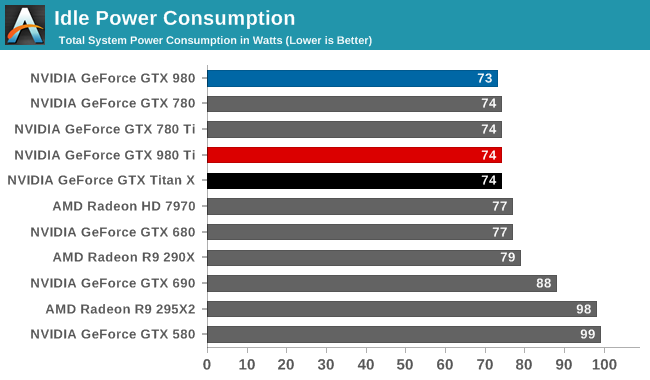
Starting off with idle power consumption, there's nothing new to report here. GTX 980 Ti performs just like the GTX Titan X, which at 74W is second only to the GTX 980 by a single watt.
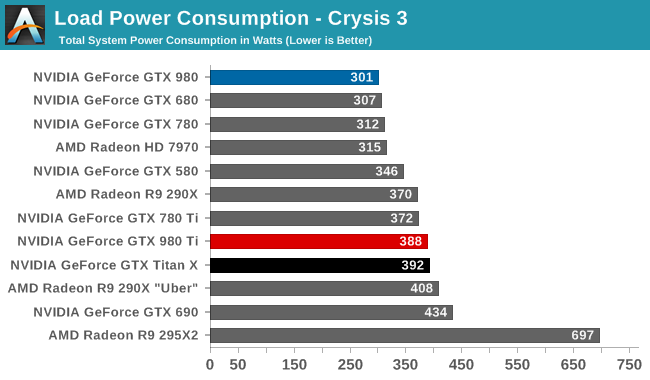
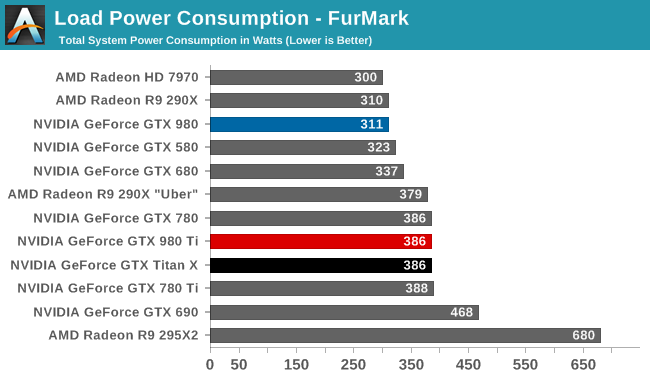
Meanwhile load power consumption is also practically identical to the GTX Titan X. With the same GPU on the same board operating at the same TDP, GTX 980 Ti ends up right where we expect it, next to GTX Titan X. GTX Titan X did very well as far as energy efficiency is concerned – setting a new bar for 250W cards – and GTX 980 Ti in turn does just as well.
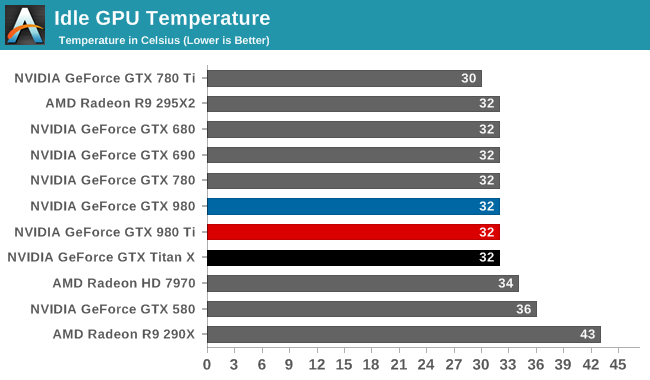
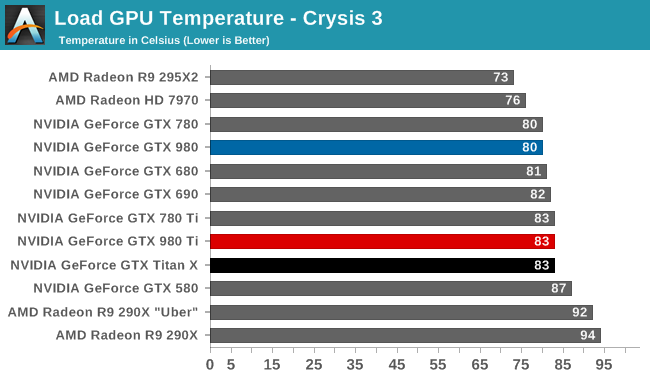
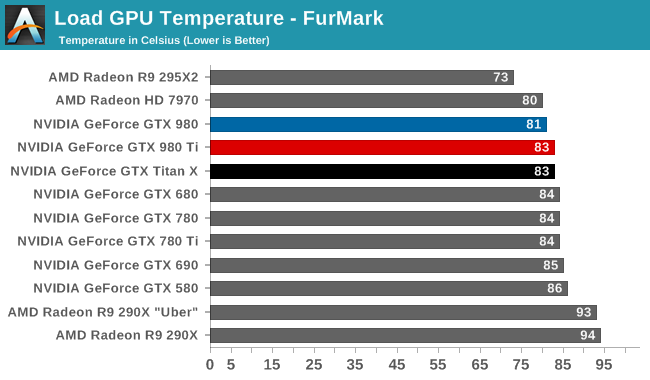
As was the case with power consumption, video card temperatures are similarly unchanged. NVIDIA’s metal cooler does a great job here, keeping temperatures low at idle while NVIDIA’s GPU Boost mechanism keeps temperatures from exceeding 83C under full load.
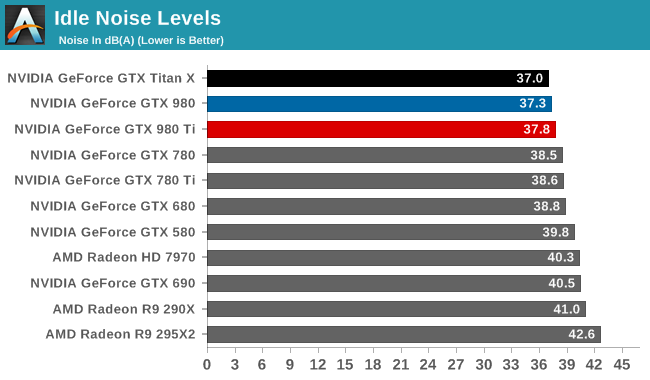
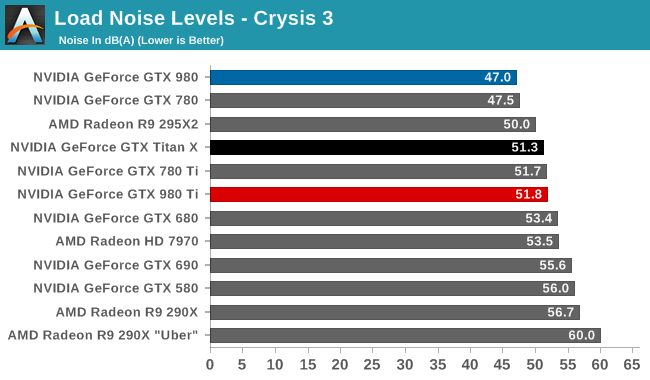
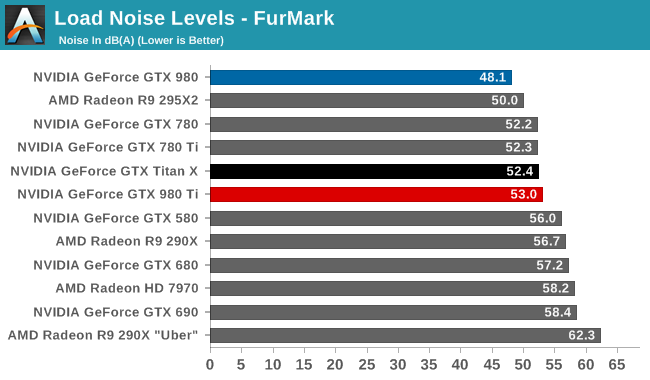
Finally for noise, the situation is much the same. Unexpected but not all that surprising, the GTX 980 Ti ends up doing a hair worse than the GTX Titan X here. NVIDIA has not changed the fan curves or TDP, so this ultimately comes down to manufacturing variability in NVIDIA’s metal cooler, with our GTX 980 Ti faring ever so slightly worse than the Titan. Which is to say that it's still right at the sweet spot for noise versus power consumption, dissipating 250W at no more than 53dB, and once again proving the mettle of NVIDIA's metal cooler.










290 Comments
View All Comments
Oxford Guy - Monday, June 1, 2015 - link
I'm sure you posted that from your 65nm processor and 80nm GPU.godrilla - Thursday, June 4, 2015 - link
Because next shrink is in the 3d chips plus hbm category and that should be amazing performance leap.Gastec - Sunday, September 4, 2016 - link
Oh yeah, that's "1337 5p34k" for ya! :PWreckage - Sunday, May 31, 2015 - link
Wait until AMD tries to sell you a rebadge for that much.Rezurecta - Sunday, May 31, 2015 - link
I don't understand the rage about rebadge all of a sudden. GPU has been doing this for YEARS!Anyway, nice card from Nvidia for a decent price.
dragonsqrrl - Sunday, May 31, 2015 - link
Don't mix up traditional rebadging and what AMD is doing with their upcoming lineup, it's unprecedented. It's also worrisome, and it's clearly a big problem for AMD. What does it say about the state of the company and their R&D budget that they'll only have 1 new GPU this coming generation? One of the big problems AMD is currently facing, amongst many other things, are their profit margins. In order to compete they're selling larger, more expensive GPU's attached to more complex memory interfaces relative to the competition, and that won't change much this coming generation as a result of these top to bottom rebadges. The situation is really becoming quite analogous to their CPU's, which should raise alarms for any informed enthusiast. It's a less than ideal situation, to put it lightly.Azix - Sunday, May 31, 2015 - link
If you post this after their launch then maybe I'd understand. As it is their Chips are almost certainly not rebadged because they aren't on TSMC and will include hardware improvements. They maybe be based on hawaii or w/e but not even nvidia managed to put out more than 2 new cards during their major launch last year. Considering this is likely the last year of 28nm launches, it may make sense for them to put out an entire line of modified chips and be done with the 300 series. Keeping it fresh till next year when they can do 2-3 on a smaller process.dragonsqrrl - Sunday, May 31, 2015 - link
"If you post this after their launch then maybe I'd understand."You realize I could just give the exact same response to the rest of your comment. But I won't.
"As it is their Chips are almost certainly not rebadged because they aren't on TSMC and will include hardware improvements.",
That's interesting, I haven't heard anything about AMD switching fabs for the 300 series. Source?
"They maybe be based on hawaii or w/e but not even nvidia managed to put out more than 2 new cards during their major launch last year."
Not quite a straight comparison there, since Nvidia also launched a new architecture with the 750Ti. Thus far we've gotten 4 new GPU's (not just cards) based on Maxwell. And we're not just talking launch here. All indications point to Fiji as the only new GPU of the coming generation for AMD. And what's more, it might not even be an updated architecture. The rest of the lineup will likely be refreshes of Hawaii, Tonga, Pitcairn, and Bonaire, ranging from GCN 1.2-1.0, with at most manufacturing revisions to improve efficiency. Again it's very important to put this in perspective, in the context of what these GPU's will be competing against. They range in feature set, and in power efficiency, none of which is anywhere close to par with Maxwell, and it's going to be very difficult for AMD to compete with this lineup for another generation. It's not a good situation for AMD. "Keeping it fresh"? How you came to spin your conclusion the way you did is beyond me.
ImSpartacus - Monday, June 1, 2015 - link
Be nice. The guy is basically telling you at this point.ImSpartacus - Monday, June 1, 2015 - link
trolling***